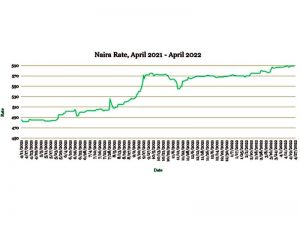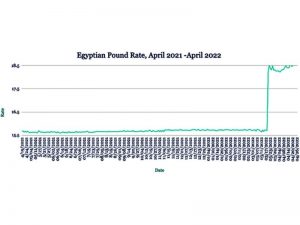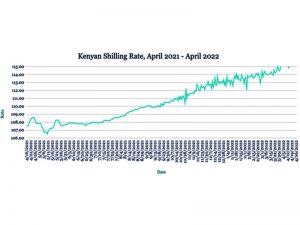The Ghanaian Cedi depreciated marginally against the dollar from 7.53 last week to 7.56. At the Money Summit in Ghana this week, the head of payments at the Bank of Ghana, Dr. Settor Amediku, said that inclusion of the Ghana Interbank Payment and Settlement Systems in the Pan-African Payment and Settlement System (PAPSS) will help deepen financial inclusion as businesses transact via mobile phones. We expect further weakening for the Cedi amid continued capital outflows and global economic fallout from the Russia-Ukraine war.
Oil to food shortages hit industry
Supply disruptions continue to be felt across Africa – from companies in Nigeria struggling to manage with the steep climb in diesel prices to the South African Canegrowers Association suffering from the combined impact of rising fertilizer costs, poor weather and an impending tax hike. In Ghana, the soaring price of liquefied natural gas is causing a return to charcoal, compromising the government’s drive to avert deforestation by distributing free gas cylinders to encourage the switch to LNG. Meantime, two Asian powerhouses have taken divergent approaches to dealing with the global food shortage. As India eagerly takes on its first assignment as a substitute wheat supplier to Egypt, Indonesia has taken a different stance by banning palm oil exports to protect domestic consumers. This ban has far reaching consequences on African countries like Kenya which depend solely on imports for its cooking oil and has already seen prices jump by 30% this year.

Naira steady at all-time low
The Naira held firm all week at 589 to the dollar in the parallel market, maintaining its weakest level on record. Nigeria and the UK agreed to enter discussions on an Enhanced Trade Partnership (ETP) in priority sectors to help strengthen bilateral trade, currently worth £3.2bn annually. Just weeks after obtaining approval from the Central Bank of Nigeria to operate as a payment service bank, MTN Nigeria completed the country’s biggest issue of commercial paper as part of its strategy to diversify financing options, raising 127bn Naira in 184- and 254 day tenors priced at 8.50% yield. We expect the Naira to hold firm in the coming days as a result of reduced demand pressure.

Rand heads for 16.00 levels for first time in 2022
The Rand dropped to 15.85 from 15.57 this week, deepening its rout after plunging almost 7% last week. The slump follows US Federal Reserve comments indicating future interest rate hikes, as well as reduced economic growth prospects for South Africa this year after the recent floods and power outages. Investors sought safety in the dollar this week as the Covid crisis in China sparks concern of slower global economic growth. Based on current trends, we expect the Rand to continue to weaken in coming days, returning to 16.00 levels for the first time this year.

Egypt diversification helps Pound outlook
The Egyptian pound weakened to 18.51 from 18.49 this week. To strengthen resilience against supply shocks from the Russia-Ukraine war, Egypt is seeking to almost double its strategic wheat reserves to 5m tons from 2.6m by upgrading the capacity of existing silos and building more. After being added to Egypt’s list of approved wheat suppliers earlier this month, India is set to ship its first cargo containing 55,000 tons of wheat. We expect the Egyptian pound to hold firm in the coming days helped by the country’s moves to diversify supplies.

Kenya’s record-low Shilling faces election dip
The Kenyan Shilling continued to depreciate against the US dollar, hitting an all-time low of 115.87 from last week’s close of 115.4, amid a dollar shortage in the face of demand from manufacturing and energy importers. Costs of production have increased due to currency depreciation and the high prices of fuel and raw materials driving inflation higher. Reserves used by the central bank to support the Shilling against volatility remain adequate at US$ 8.485 billion, covering for 5.04 months of imports. With the uncertainty around the general election scheduled for August, foreign investors are likely to exit local capital markets, pushing the Shilling lower in the short term.

Uganda Shilling losses to extend on month-end dollar demand
The Ugandan shilling was on the backfoot this week, losing ground to 3560 from 3520 ahead of next week’s Eid holidays. Uganda’s central bank maintained its key lending rate at 6.5% despite inflation rising to 3.7% in March 2022 from 3.2% – a level still lower than in many other African economies. We expect continued pressure on the Shilling as importers fulfilling month-end contracts boost dollar demand.

US investments in Tanzania to lift jobs and Shilling
Tanzania’s Shilling weakened to 2,320/2,330 from last week’s close at 2318/2328 amid increased dollar demand from importers, especially manufacturers. As the war in Ukraine hampers the global economic recovery, the IMF projects Tanzania’s GDP growth at 4.8% for 2022, a decline from 4.9% in 2021, with projections for 5.2% in 2023. Meanwhile, the US signed seven agreements totaling Sh11.7 trillion for business projects in Tanzania to be implemented by investors. This should help to spur employment opportunities in agriculture, tourism, trade and other sectors. The inflows should help to steady the Shilling.









